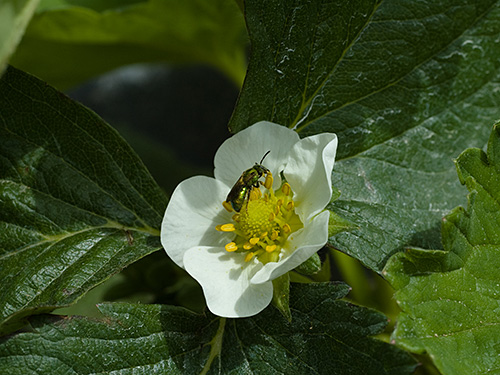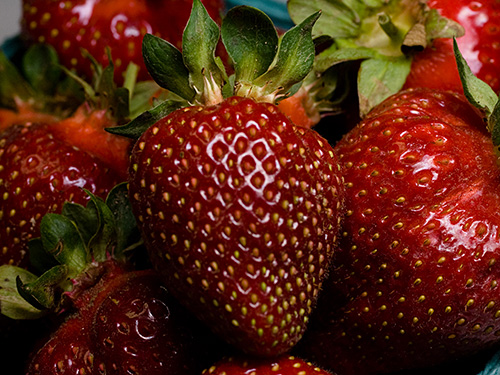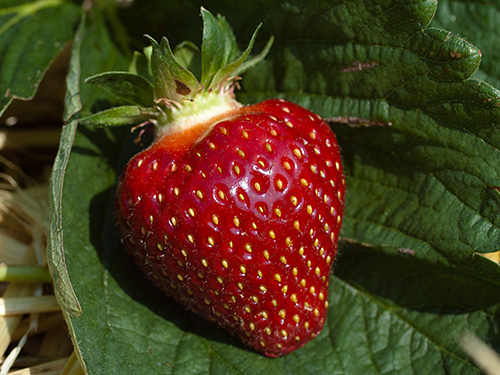
Fact Sheet FS097
Strawberries can be an easy and delicious fruit crop for the home garden if a few cultural requirements are met. Fortunately, strawberries can thrive in a wide range of soil types and conditions throughout New Jersey.
Site Selection
Like most fruit crops, strawberry plants require as much exposure to sunlight as possible, so a site with full sun all day or at least 8 hours of sun is desirable. Some late-afternoon shade is tolerable in mid-summer, but yield is reduced in shady areas.
Sites with well-drained soil are best for strawberry plant health and growth. If a site has heavy soils that have high clay content and/or are poorly drained, consider amending the soil with organic matter or utilize raised beds (a bed raised above the surrounding area typically framed by wood or stones) to improve the drainage.
It is also advantageous to select a site with good air drainage: a gentle slope or the top of a hill. Strawberries flower at a time when there is still a chance for late spring frosts which can kill the flowers. Avoiding low-lying areas will help to avoid settling of cold air around the plants (frost pockets) and help to prevent damage to newly opened flowers.
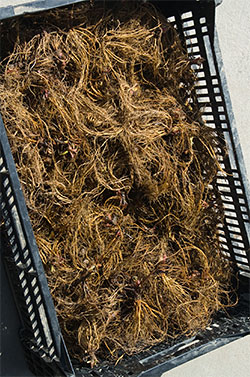
Figure 1. Dormant strawberry crowns.
Plant and Cultivar Selection
When purchasing strawberry plants, look for nurseries that offer virus-indexed (tested and deemed virus disease-free) plants. Strawberry plants are typically sold as dormant crowns (Figure 1). Dormant crowns should be planted in the garden as soon as possible or kept moist and cool, by wrapping them in damp paper and placing them in a plastic bag in a refrigerator (1–3 weeks), until ready to plant. Avoid placing dormant crowns in a refrigerator filled with fruit such as apples or pineapple, which will produce natural ethylene ripening gas and begin to break the dormancy of the plants prematurely.
Strawberries are also sold in garden centers as actively growing potted plants. These potted plants should be kept watered and in full sunlight until they can be transplanted into the garden.
There are two types of strawberry cultivars. June-bearers flower and fruit only in the spring, while day-neutral cultivars produce both a spring and fall crop. The performance of strawberry cultivars varies widely with local environmental conditions. Experiment with several cultivars to determine which will perform the best at a specific site. Planting several cultivars with different ripening seasons can also help to extend the harvest season. The use of disease-resistant strawberry cultivars is recommended especially on poorly drained sites to help reduce the occurrence of two primary diseases of strawberry: red stele and verticillium wilt.
Strawberry Cultivars
The following cultivars are recommended for New Jersey:
| Variety | Season | Resistance to Verticillium Wilt | Resistance to Red Stele |
|---|---|---|---|
| June-Bearing | |||
| AC Wendy | Early | S | T |
| Annapolis | Early | T | R |
| Earliglow | Early | T | R |
| Allstar | Mid | T | R |
| Darselect | Mid | U | U |
| Flavorfest | Mid | U | R |
| Rutgers Scarlet | Mid | U | U |
| Jewel | Late | S | S |
| AC Valley Sunset (trial) | Late | U | U |
| Day-Neutral | |||
| Albion | R | U | |
| Tribute | T | R | |
| Tristar | R | R | |
R= resistant; T=tolerant, S= susceptible, U= unknown
Note: Varieties with resistance to specific diseases do not become infected or show symptoms, while tolerant varieties will get the disease but the symptoms are delayed or reduced in severity.
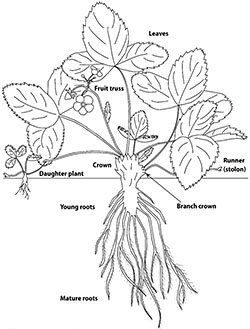
Figure 2. Parts of a strawberry plant.
Soil Preparation and Planting
Preparations for any crop should begin with a soil test. Test kits with mailing envelopes and soil sampling instructions can be obtained at your local county Rutgers Cooperative Extension office. Forms and instructions are also available online at njaes.rutgers.edu/soil-testing-lab/how-to.php.
The test results will indicate the pH of the soil, the level of certain macro- and micronutrients, and recommend appropriate amendments. The optimal soil pH range for strawberry growth is 6.0–6.5.
In the absence of a soil test, apply 5-10-10 or 10-10-10 at a rate of 2 pounds per 100 square feet when the first runners or daughter plants (Figure 2) are rooting, and again in mid-August.
June-bearing strawberry plants should be transplanted 24–36" apart and dayneutrals 12–24" apart in rows 4 feet apart. Take care to set strawberry plants at the proper depth (see Figure 2). The growing bud should be exposed to sunlight, the roots spread, and well-covered with soil. Keep newly planted strawberries well-watered.
Good weed control is important because strawberries do not compete well for water, nutrients, and sunlight. Weeds also can be a source of diseases and harbor insects. Weeds can be controlled mechanically by hand-weeding and shallow hoeing or cultivation. Small weeds remove easier and die faster than large weeds with well-established root systems. Mulch can also be used to prevent germination and growth of weeds.
Mulch can be laid around the strawberry crowns after planting, and gradually removed where runners are beginning to root. The down side is that mulch may harbor pests such as slugs or rodents.
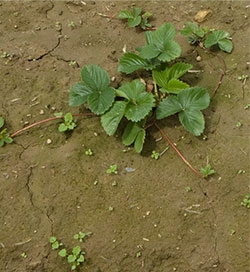
Figure 3. Strawberry plant producing runners.
Establishing a Bed
Strawberry plants will break dormancy and produce leaves and then flowers soon after transplanting into the garden. During the first year all of the flowers of June bearing strawberries should be removed. For day-neutral strawberries the flowers should be removed for the first six weeks but flowers produced later in the summer can be left to grow fruit in the fall. Flower removal will help encourage strawberry plants to produce runners that will root and form new plants (Figure 3). The runners should be encouraged to develop multiple new plants in what is called a matted row. Ideally, the runner plants should be moved/trained to root evenly across a bed 12–18" wide.
Overwintering
To overwinter the strawberry bed, cover with clean (free of weeds and mature grain heads) straw mulch 4" deep to protect the plants from severe cold, fluctuating temperatures, and soil heaving. Mulch should be applied once the plants have become dormant, typically in early to mid-December. Mulch should be removed when the plant resumes growth in the spring (typically late March). Remove the straw from on top of the bed to the side of the row where it will then serve as a mulch to block weeds and keep berries clean.
Frost Protection
Open strawberry blossoms are sensitive to sub-freezing temperatures. A good way to prevent damage to flowers is to cover the bed with lightweight cloth or floating rowcovers. Floating rowcovers are a cloth-like material that trap heat from the sun and increase the temperature underneath a few degrees. Rowcovers or light cloth should be applied before nights when open blooms will be subjected to sub-32°F temps. Covers should be removed during the daylight when temperatures rise again to allow for insect pollination, and replaced before nightfall if necessary. Blossoms with black centers have been damaged by cold temperatures and will not develop into fruit.
Renovation
If a strawberry planting is to be fruited another year, it needs to be renovated after harvest to rejuvenate the planting. The leaves should be removed using a lawn mower set high, or line trimmer, being careful not to damage the crown. Rows should be narrowed to 12" by digging out or rototilling and removing the oldest plants. It is important that the planting does not become too dense, since this will cause a decrease in fruit size and an increase in disease and insect pressure.
Fertilizer should be applied to renew (invigorate) the planting. In the absence of a soil test, 5-10-10 fertilizer should be applied at 2 lbs/100 square feet at renovation, and again in mid-August to re-establish a healthy bed of plants. It is best to fruit the same planting no more than three years to maintain optimal production and quality. New strawberry plantings of purchased virus-free stock can be established during the last year of fruiting of the old planting, to allow for a year of establishment, without sacrificing yield.
Harvest and Storage
Strawberries are ready to pick 30 days after they bloom. Fruit should be allowed to ripen on the plant and picked in the morning when cool. Pick ripe fruit and remove any diseased, overripe, or damaged fruit from the garden. Leave the green calyx (cap) attached to the fruit to increase storability. Place uneaten ripe fruit in plastic bags or plastic or glass containers and refrigerate immediately. Do not wash fruit before storage but wash immediately before consumption. When picked cool and refrigerated, strawberries can often be stored up to a week.
September 2016
Copyright © 2024 Rutgers, The State University of New Jersey. All rights reserved.
For more information: njaes.rutgers.edu.
Cooperating Agencies: Rutgers, The State University of New Jersey, U.S. Department of Agriculture, and Boards of County Commissioners. Rutgers Cooperative Extension, a unit of the Rutgers New Jersey Agricultural Experiment Station, is an equal opportunity program provider and employer.


